Real-Time Estimation of PEMFC Parameters Using a Continuous-Discrete Extended Kalman Filter Derived from a Pseudo Two-Dimensional Model
Abstract
:1. Introduction
1.1. Background
1.2. Literature Review
1.3. Study Aim
1.4. Nomenclature and Constants
2. Physical Two-Dimensional Model
2.1. Geometry and Assumptions
- Oxygen transport in the cathode catalyst layer (CCL) is fast;
- The oxygen transport in the GDL is purely 1D in the x-direction;
- The oxygen transport in the channel is assumed to be a plug-flow with an averaged velocity and the choice of plug flow in fuel cell microchannels is justified by the small dimensions of the channels. It was shown in previous studies [29,30] that the laminar velocity profile in rectangular microchannels is flat at the center. Thus, at the first order and given the high mass diffusivity of air in the cathode channel, one can assume that the average velocity of a plug flow is able to give a good description of the mass transfer in the fuel cell microchannels;
- The model is isothermal;
- The CL is supposed to be infinitely small;
- The voltage potential is equal along the CL in the y-dimension;
- All channels of the cell are supposed to be operated in the same condition such as temperature, humidity, etc.; and
- The concentrations in the canal and the GDL are supposed to be equal (concentration on the channel inlet) before any current is applied to the FC.
2.2. General Equations
2.3. Normalized Adimensional Equations
3. Finite-Difference Discretization
4. Description of the Experimental Test Bench and Considered Fuel Cell
5. Experimental Validation of PEMFC Model
5.1. Current Profile with Step-Up
5.2. Current Profile with Forward/Backward Sweeps
6. Estimating the PEMFC Parameters Using an Extended Kalman Filter
7. Results of the EKF Observer and Discussion
7.1. Current Profile with Forward/Backward Sweeps
7.2. Current Profile with Step-Up/Down
7.3. Modified PEMFC Cell with Step-Up/Down Profile
8. Conclusions
Author Contributions
Funding
Institutional Review Board Statement
Informed Consent Statement
Data Availability Statement
Conflicts of Interest
Appendix A
Appendix B
Appendix C
References
- Du, Z.; Liu, C.; Zhai, J.; Guo, X.; Xiong, Y.; Su, W.; He, G. A Review of Hydrogen Purification Technologies for Fuel Cell Vehicles. Catalysts 2021, 11, 393. [Google Scholar] [CrossRef]
- Madsen, R.T.; Klebanoff, L.E.; Caughlan, S.A.M.; Pratt, J.W.; Leach, T.S.; Appelgate Jr, T.B.; Kelety, S.Z.; Wintervoll, H.-C.; Haugom, G.P.; Teo, A.T.Y. Feasibility of the Zero-V: A Zero-Emissions Hydrogen Fuel-Cell Coastal Research Vessel. Int. J. Hydrogen Energy 2020, 45, 25328–25343. [Google Scholar] [CrossRef]
- Klebanoff, L.; Pratt, J.; Johnson, T.; Arienti, M.; Shaw, L.; Moreno, M. Analysis of H2 Storage Needs for Early Market Non-Motive Fuel Cell Applications; Technical Report SAND2012-17392012; Sandia National Laboratories: Livermore, CA, USA, 2012. [Google Scholar]
- Ursua, A.; Gandia, L.M.; Sanchis, P. Hydrogen Production from Water Electrolysis: Current Status and Future Trends. Proc. IEEE 2012, 100, 410–426. [Google Scholar] [CrossRef]
- Gray, E.M.; Webb, C.J.; Andrews, J.; Shabani, B.; Tsai, P.J.; Chan, S.L.I. Hydrogen Storage for Off-Grid Power Supply. Int. J. Hydrogen Energy 2011, 36, 654–663. [Google Scholar] [CrossRef]
- Petrovic, S.; Hossain, E. Development of a Novel Technological Readiness Assessment Tool for Fuel Cell Technology. IEEE Access 2020, 8, 132237–132252. [Google Scholar] [CrossRef]
- Larminie, J.; Dicks, A.; McDonald, M.S. Fuel Cell Systems Explained; J. Wiley: Chichester, UK, 2003; Volume 2. [Google Scholar]
- Zhong, Z.-D.; Zhu, X.-J.; Cao, G.-Y.; Shi, J.-H. A Hybrid Multi-Variable Experimental Model for a PEMFC. J. Power Source 2007, 164, 746–751. [Google Scholar] [CrossRef]
- Zhong, Z.-D.; Zhu, X.-J.; Cao, G.-Y. Modeling a PEMFC by a Support Vector Machine. J. Power Source 2006, 160, 293–298. [Google Scholar] [CrossRef]
- Husar, A.; Strahl, S.; Riera, J. Experimental Characterization Methodology for the Identification of Voltage Losses of PEMFC: Applied to an Open Cathode Stack. Int. J. Hydrogen Energy 2012, 37, 7309–7315. [Google Scholar] [CrossRef] [Green Version]
- Tang, Y.; Yuan, W.; Pan, M.; Li, Z.; Chen, G.; Li, Y. Experimental Investigation of Dynamic Performance and Transient Responses of a KW-Class PEM Fuel Cell Stack under Various Load Changes. Appl. Energy 2010, 87, 1410–1417. [Google Scholar] [CrossRef]
- Shi, Y.; Janßen, H.; Lehnert, W. A Transient Behavior Study of Polymer Electrolyte Fuel Cells with Cyclic Current Profiles. Energies 2019, 12, 2370. [Google Scholar] [CrossRef] [Green Version]
- Zhang, G.; Wu, L.; Qin, Z.; Wu, J.; Xi, F.; Mou, G.; Wang, Y.; Jiao, K. A Comprehensive Three-Dimensional Model Coupling Channel Multi-Phase Flow and Electrochemical Reactions in Proton Exchange Membrane Fuel Cell. Adv. Appl. Energy 2021, 2, 100033. [Google Scholar] [CrossRef]
- Barragán, A.J.; Enrique, J.M.; Segura, F.; Andújar, J.M. Iterative Fuzzy Modeling of Hydrogen Fuel Cells by the Extended Kalman Filter. IEEE Access 2020, 8, 180280–180294. [Google Scholar] [CrossRef]
- Zhao, J.; Jian, Q.; Luo, L.; Huang, B.; Cao, S.; Huang, Z. Dynamic Behavior Study on Voltage and Temperature of Proton Exchange Membrane Fuel Cells. Appl. Therm. Eng. 2018, 145, 343–351. [Google Scholar] [CrossRef]
- Abbou, A.; El Hasnaoui, A.; Khan, S.S.; Yamin, F. Analysis of the Novel Dynamic Semiempirical Model of Proton Exchange Membrane Fuel Cell by Incorporating Ambient Condition Variations. Int. J. Energy Environ. Eng. 2021, 12, 1–16. [Google Scholar] [CrossRef]
- Lajnef, T.; Abid, S.; Ammous, A. Modeling, Control, and Simulation of a Solar Hydrogen/Fuel Cell Hybrid Energy System for Grid-Connected Applications. Adv. Power Electron. 2013, 2013, 1–9. [Google Scholar] [CrossRef] [Green Version]
- San Martín, I.; Ursúa, A.; Sanchis, P. Modelling of PEM Fuel Cell Performance: Steady-State and Dynamic Experimental Validation. Energies 2014, 7, 670–700. [Google Scholar] [CrossRef] [Green Version]
- Sousa, R.; Gonzalez, E.R. Mathematical Modeling of Polymer Electrolyte Fuel Cells. J. Power Source 2005, 147, 32–45. [Google Scholar] [CrossRef]
- Luna, J.; Ocampo-Martinez, C.; Serra, M. Nonlinear Predictive Control for the Concentrations Profile Regulation under Unknown Reaction Disturbances in a Fuel Cell Anode Gas Channel. J. Power Source 2015, 282, 129–139. [Google Scholar] [CrossRef] [Green Version]
- Petrone, R.; Zheng, Z.; Hissel, D.; Péra, M.-C.; Pianese, C.; Sorrentino, M.; Becherif, M.; Yousfi-Steiner, N. A Review on Model-Based Diagnosis Methodologies for PEMFCs. Int. J. Hydrogen Energy 2013, 38, 7077–7091. [Google Scholar] [CrossRef]
- Chevalier, S.; Auvity, B.; Olivier, J.C.; Josset, C.; Trichet, D.; Machmoum, M. Detection of Cells State-of-Health in PEM Fuel Cell Stack Using EIS Measurements Coupled with Multiphysics Modeling. Fuel Cells 2014, 14, 416–429. [Google Scholar] [CrossRef]
- Fouquet, N.; Doulet, C.; Nouillant, C.J.J.; Dauphin-Tanguy, G.; Ould-Bouamama, B. Model Based PEM Fuel Cell State-of-Health Monitoring via Ac Impedance Measurements. J. Power Source 2006, 159, 905–913. [Google Scholar] [CrossRef]
- Jouin, M.; Gouriveau, R.; Hissel, D.; Péra, M.-C.; Zerhouni, N. Prognostics of PEM Fuel Cell in a Particle Filtering Framework. Int. J. Hydrogen Energy 2014, 39, 481–494. [Google Scholar] [CrossRef] [Green Version]
- Jouin, M.; Gouriveau, R.; Hissel, D.; Péra, M.-C.; Zerhouni, N. Remaining Useful Life Estimates of a PEM Fuel Cell Stack by Including Characterization-Induced Disturbances in a Particle Filter Model. In Proceedings of the Conference Internationale Discussion on Hydrogen Energy and Applications, IDHEA’14, Nantes, France, 14 January 2014; pp. 1–10. [Google Scholar]
- Luna, J.; Usai, E.; Husar, A.; Serra, M. Distributed Parameter Nonlinear State Observer with Unmatched Disturbance Estimation for PEMFC Systems. In Proceedings of the 6th International Conference on “Fundamentals & Development of Fuel Cells”, Tolouse, France, 27 May 2015. [Google Scholar]
- Luna, J.; Usai, E.; Husar, A.; Serra, M. Observation of the Electrochemically Active Surface Area in a Proton Exchange Membrane Fuel Cell. In Proceedings of the IECON 2016-42nd Annual Conference of the IEEE Industrial Electronics Society, Florence, Italy, 24–27 October 2016; pp. 5483–5488. [Google Scholar]
- Chevalier, S.; Josset, C.; Bazylak, A.; Auvity, B. Measurements of Air Velocities in Polymer Electrolyte Membrane Fuel Cell Channels Using Electrochemical Impedance Spectroscopy. J. Electrochem. Soc. 2016, 163, F816–F823. [Google Scholar] [CrossRef]
- Bruus, H. Theoretical Microfluidics; Oxford University Press Inc.: New York, NY, USA, 2008; Volume 18. [Google Scholar]
- Chevalier, S. Semianalytical Modeling of the Mass Transfer in Microfluidic Electrochemical Chips. Phys. Rev. E 2021, 104, 035110. [Google Scholar] [CrossRef] [PubMed]
- Mainka, J. Local Impedance in H2/Air Proton Exchange Membrane Fuel Cells (PEMFC): Theoretical and Experimental Investigations. Ph.D. Thesis, Université Henri Poincaré-Nancy, Nancy, France, 2011. [Google Scholar]
- Chevalier, S.; Olivier, J.-C.; Josset, C.; Auvity, B. Polymer Electrolyte Membrane Fuel Cell Operating in Stoichiometric Regime. J. Power Source 2019, 440, 227100. [Google Scholar] [CrossRef]
- Abdin, Z.; Webb, C.J.; Gray, E. PEM Fuel Cell Model and Simulation in Matlab–Simulink Based on Physical Parameters. Energy 2016, 116, 1131–1144. [Google Scholar] [CrossRef]
- Youssef, M.E.; Amin, R.S.; El-Khatib, K.M. Development and Performance Analysis of PEMFC Stack Based on Bipolar Plates Fabricated Employing Different Designs. Arab. J. Chem. 2018, 11, 609–614. [Google Scholar] [CrossRef] [Green Version]
- Diab, Y.; Auger, F.; Schaeffer, E.; Wahbeh, M. Estimating Lithium-Ion Battery State of Charge and Parameters Using a Continuous-Discrete Extended Kalman Filter. Energies 2017, 10, 1075. [Google Scholar] [CrossRef] [Green Version]
- Xiong, R.; He, H.; Sun, F.; Zhao, K. Evaluation on State of Charge Estimation of Batteries with Adaptive Extended Kalman Filter by Experiment Approach. IEEE Trans. Veh. Technol. 2013, 62, 108–117. [Google Scholar] [CrossRef]
- Zhang, C.P.; Liu, J.Z.; Sharkh, S.M.; Zhang, C.N. Identification of Dynamic Model Parameters for Lithium-Ion Batteries Used in Hybrid Electric Vehicles. High Technol. Lett. 2010, 16, 6–12. [Google Scholar] [CrossRef]
- He, H.; Xiong, R.; Zhang, X.; Sun, F.; Fan, J. State-of-Charge Estimation of the Lithium-Ion Battery Using an Adaptive Extended Kalman Filter Based on an Improved Thevenin Model. IEEE Trans. Veh. Technol. 2011, 60, 1461–1469. [Google Scholar]
- Kulikov, G.Y.; Kulikova, M.V. Accurate Numerical Implementation of the Continuous-Discrete Extended Kalman Filter. IEEE Trans. Autom. Control 2014, 59, 273–279. [Google Scholar] [CrossRef]
- Axelsson, P.; Gustafsson, F. Discrete-Time Solutions to the Continuous-Time Differential Lyapunov Equation with Applications to Kalman Filtering. IEEE Trans. Autom. Control 2015, 60, 632–643. [Google Scholar] [CrossRef] [Green Version]
- Auger, F.; Hilairet, M.; Guerrero, J.M.; Monmasson, E.; Orlowska-Kowalska, T.; Katsura, S. Industrial Applications of the Kalman Filter: A Review. IEEE Trans. Ind. Electron. 2013, 60, 5458–5471. [Google Scholar] [CrossRef] [Green Version]
- Mazzoni, T. Computational Aspects of Continuous–Discrete Extended Kalman-Filtering. Comput. Stat. 2008, 23, 519–539. [Google Scholar] [CrossRef] [Green Version]
- Guihal, J.-M.; Auger, F.; Bernard, N.; Schaeffer, E. Efficient Implementation of Continuous-Discrete Extended Kalman Filters for State and Parameter Estimation of Nonlinear Dynamic Systems. IEEE Trans. Ind. Inform. 2021, 18, 3077–3085. [Google Scholar] [CrossRef]
- Lee, C.-Y.; Lee, Y.-M.; Lee, S.-J. Local Area Water Removal Analysis of a Proton Exchange Membrane Fuel Cell under Gas Purge Conditions. Sensors 2012, 12, 768–783. [Google Scholar] [CrossRef] [Green Version]
- Pérez-Page, M.; Pérez-Herranz, V. Effect of the Operation and Humidification Temperatures on the Performance of a PEM Fuel Cell Stack. Ecs Trans. 2009, 25, 733. [Google Scholar] [CrossRef]
- Pauchet, J.; Prat, M.; Schott, P.; Pulloor Kuttanikkad, S. Performance Loss of Proton Exchange Membrane Fuel Cell Due to Hydrophobicity Loss in Gas Diffusion Layer: Analysis by Multiscale Approach Combining Pore Network and Performance Modelling. Int. J. Hydrogen Energy 2012, 37, 1628–1641. [Google Scholar] [CrossRef] [Green Version]
- Emerson, A.; Montville, L. Electrochemical Characterization and Water Balance of a PEM Fuel Cell; Worcester Polytechnic Institute: Worcester, MA, USA, 2010. [Google Scholar]
- Niu, H.; Ji, C.; Wang, S.; Liang, C. Quantitative Analysis on Cold Start Process of a PEMFC Stack with Intake Manifold. Int. J. Hydrogen Energy 2021, 47, 2647–2661. [Google Scholar] [CrossRef]
- Promislow, K.S. Phase Change and Hysteresis in PEMFCs. In Device and Materials Modeling in PEM Fuel Cells; Springer: New York, NY, USA, 2009; pp. 253–295. [Google Scholar]
- Laribi, S.; Mammar, K.; Sahli, Y.; Koussa, K. Air Supply Temperature Impact on the PEMFC Impedance. J. Energy Storage 2018, 17, 327–335. [Google Scholar] [CrossRef]
- Saleh, M.M.; Okajima, T.; Hayase, M.; Kitamura, F.; Ohsaka, T. Exploring the Effects of Symmetrical and Asymmetrical Relative Humidity on the Performance of H2/Air PEM Fuel Cell at Different Temperatures. J. Power Source 2007, 164, 503–509. [Google Scholar] [CrossRef]
- Gaumont, T.; Maranzana, G.; Lottin, O.; Dillet, J.; Guétaz, L.; Pauchet, J. In Operando and Local Estimation of the Effective Humidity of PEMFC Electrodes and Membranes. J. Electrochem. Soc. 2017, 164, F1535. [Google Scholar] [CrossRef] [Green Version]

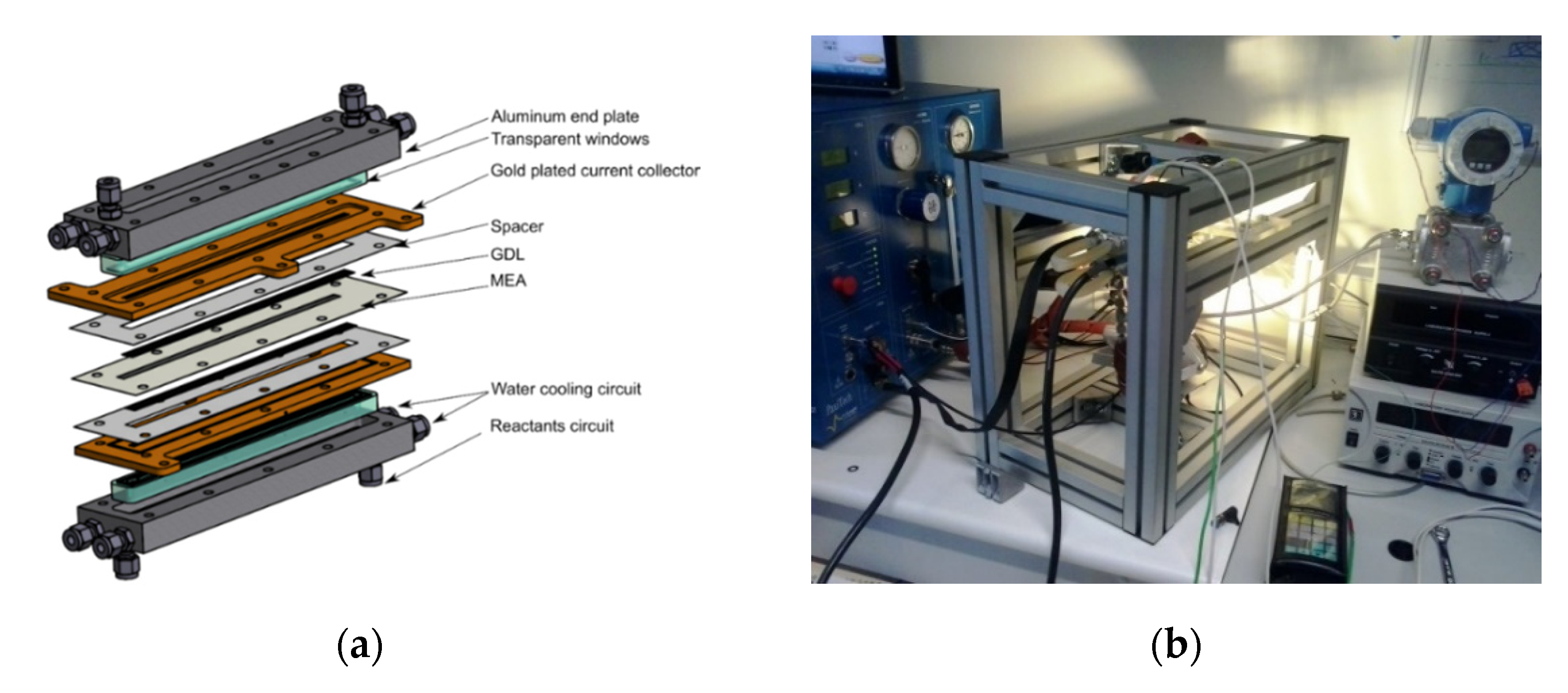

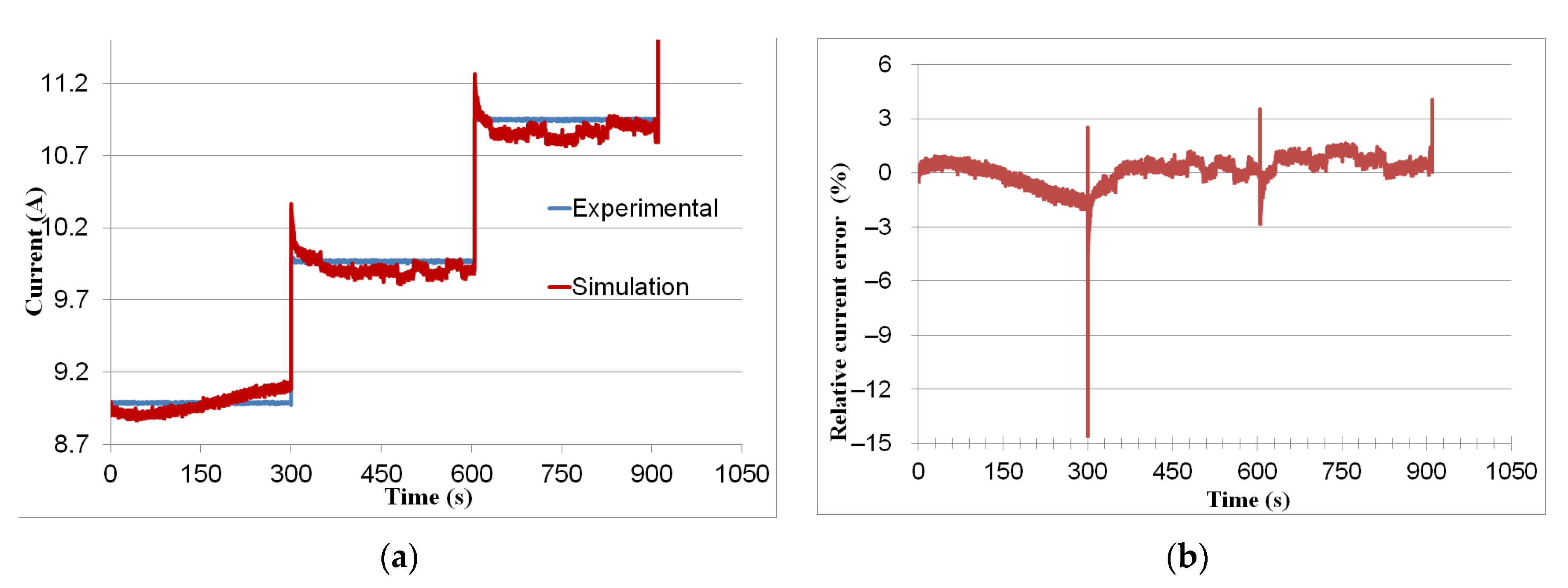
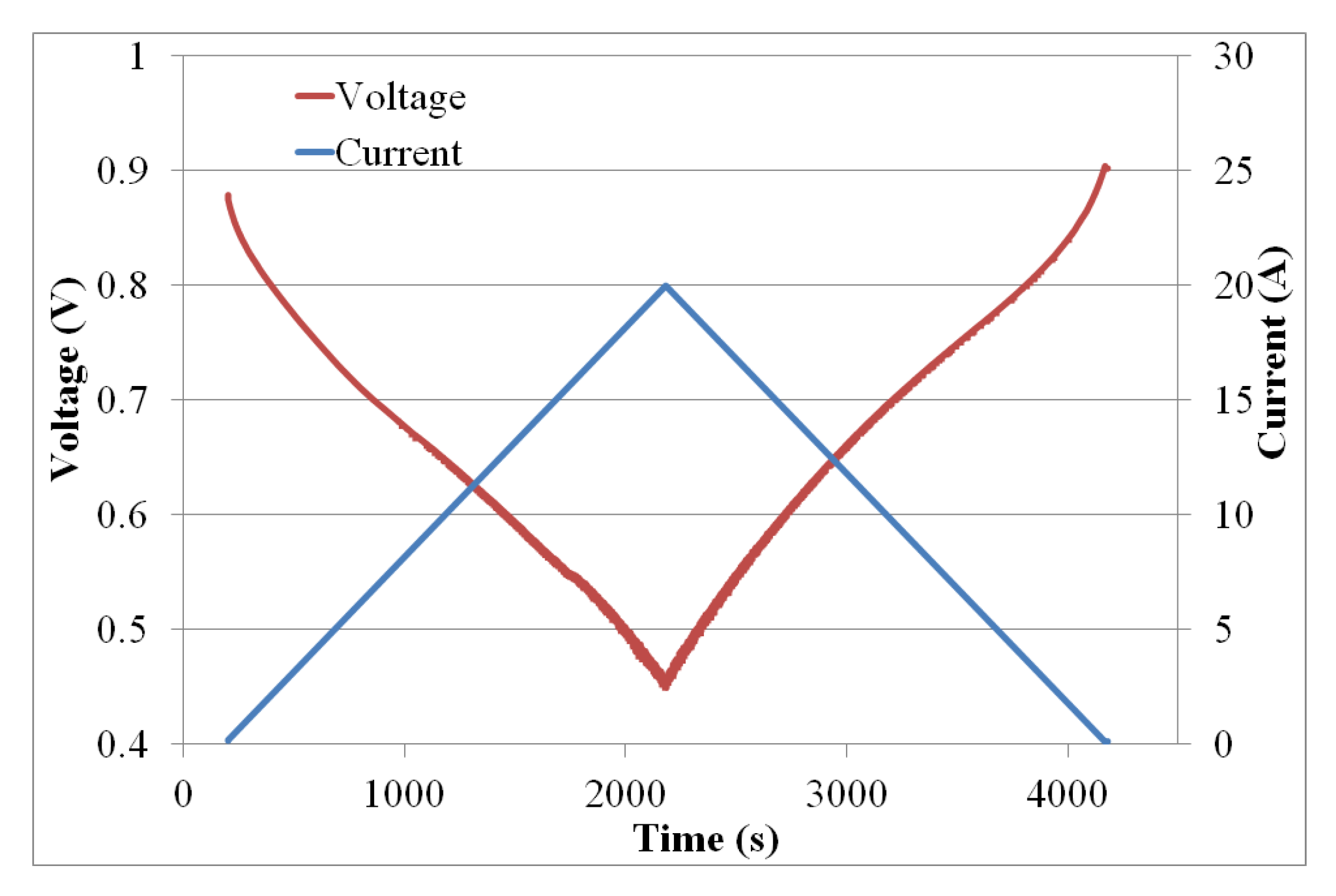
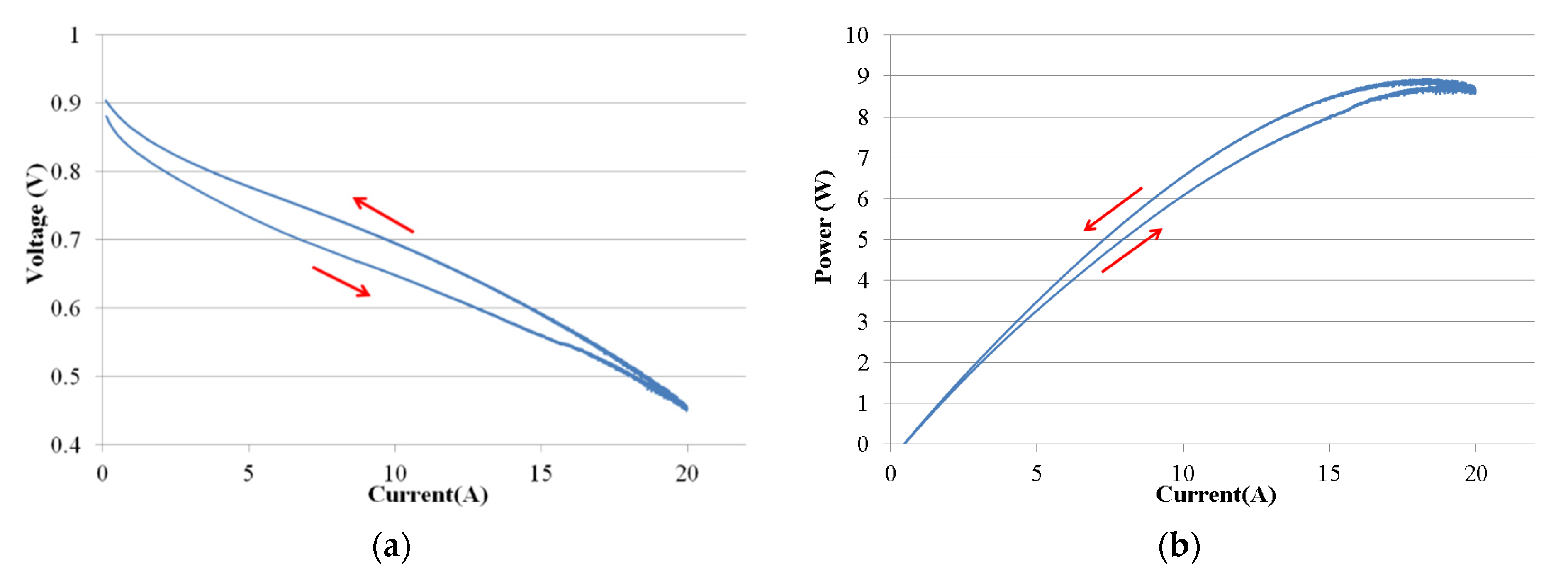
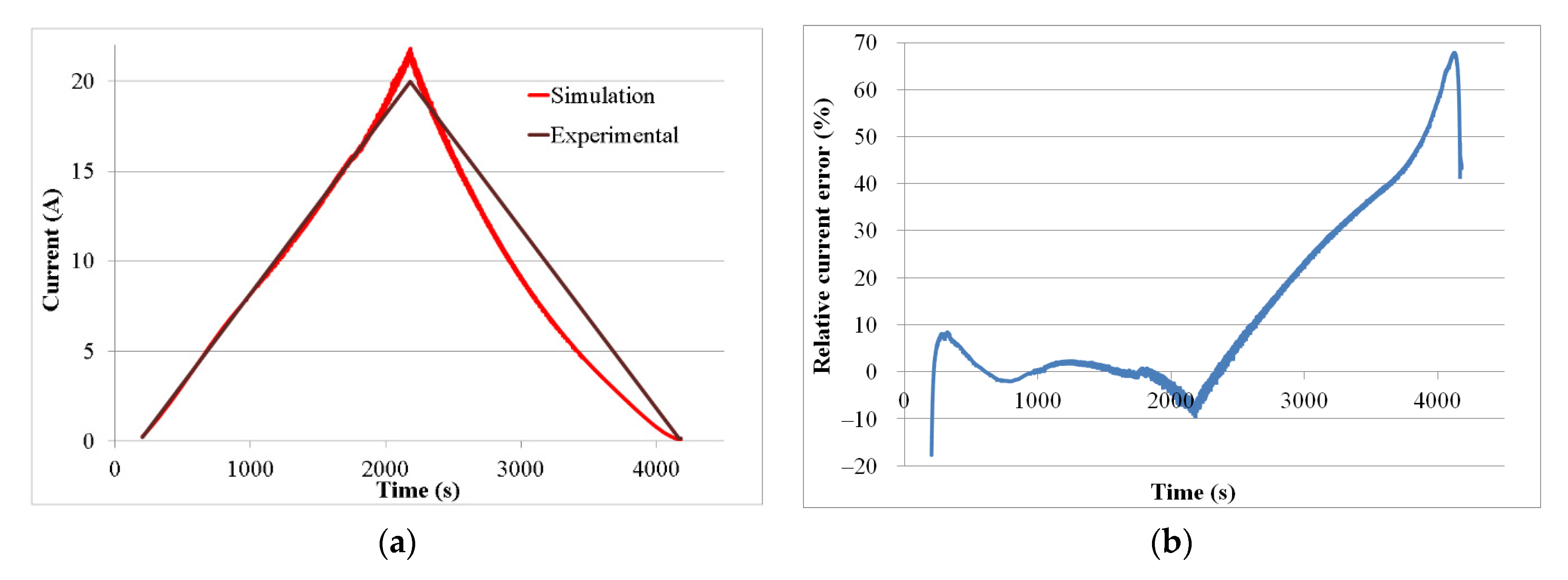
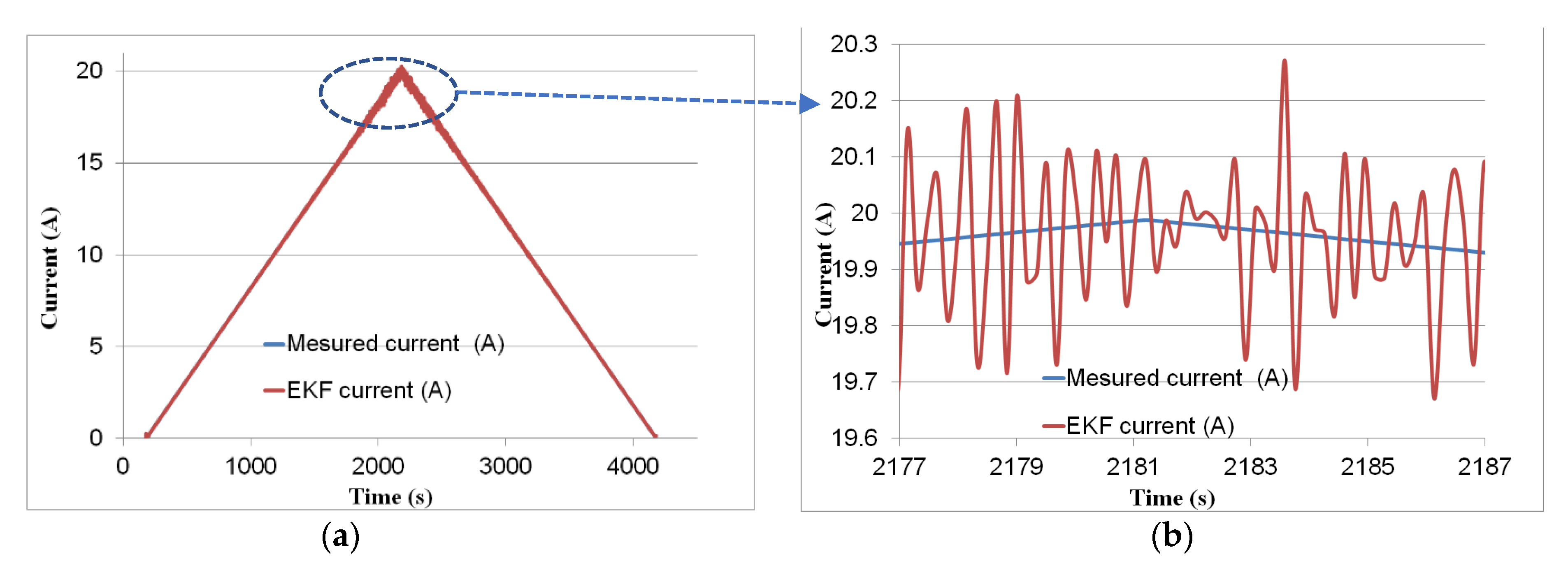
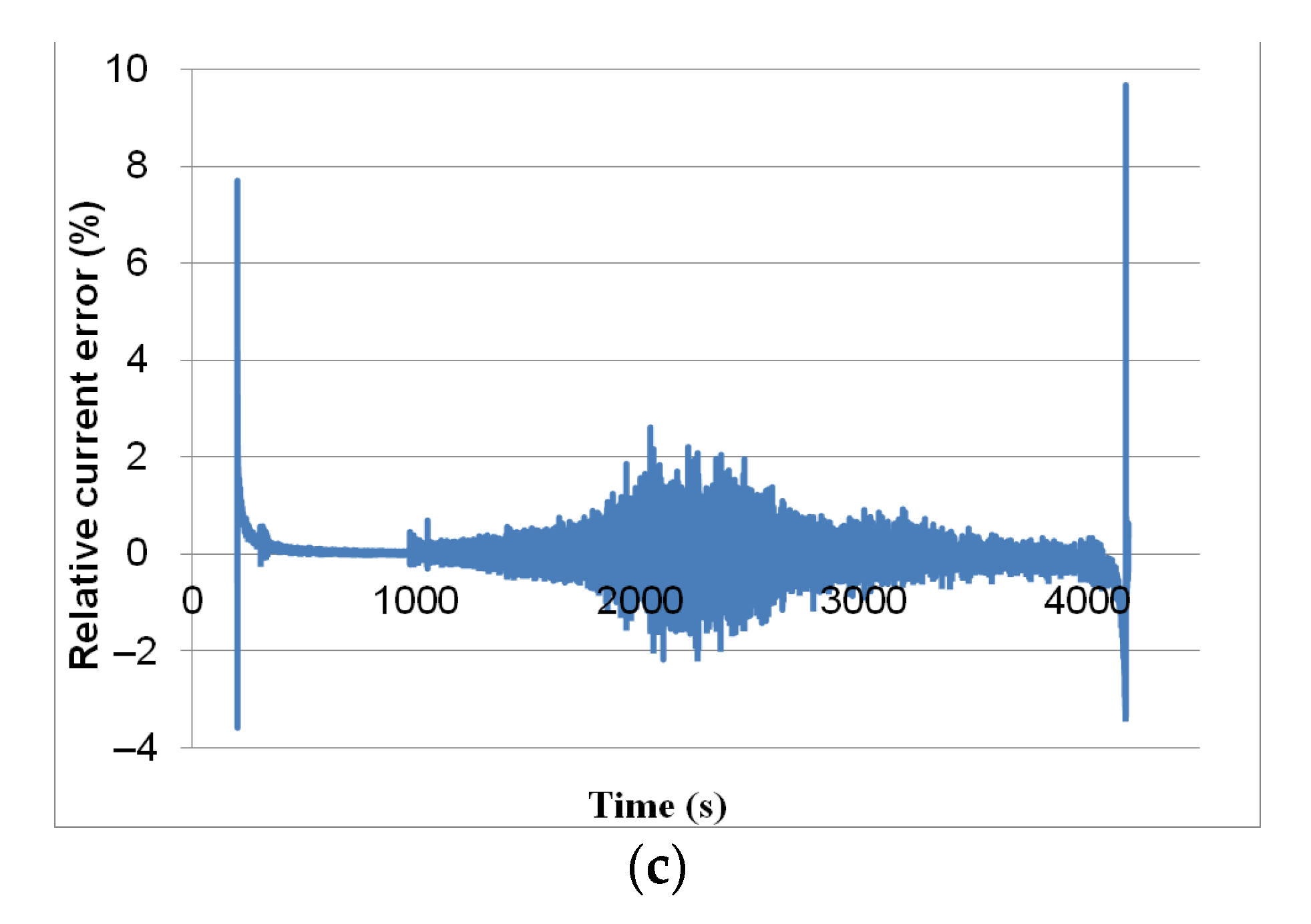


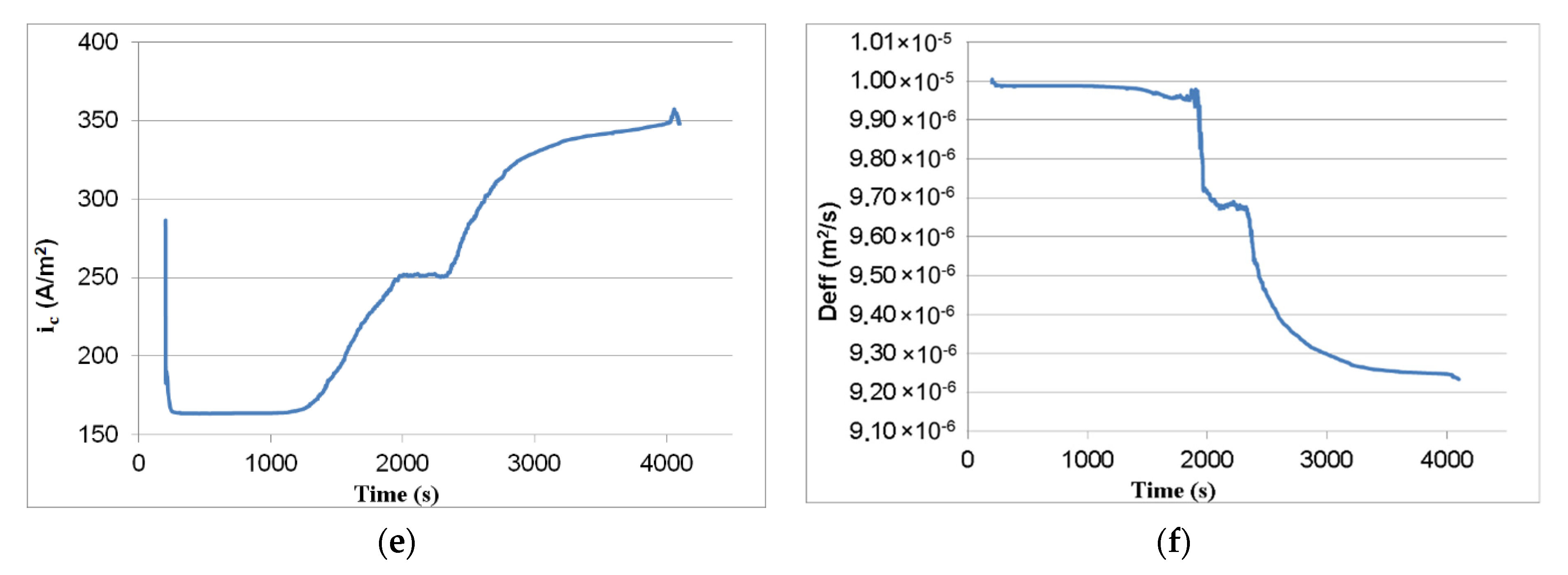

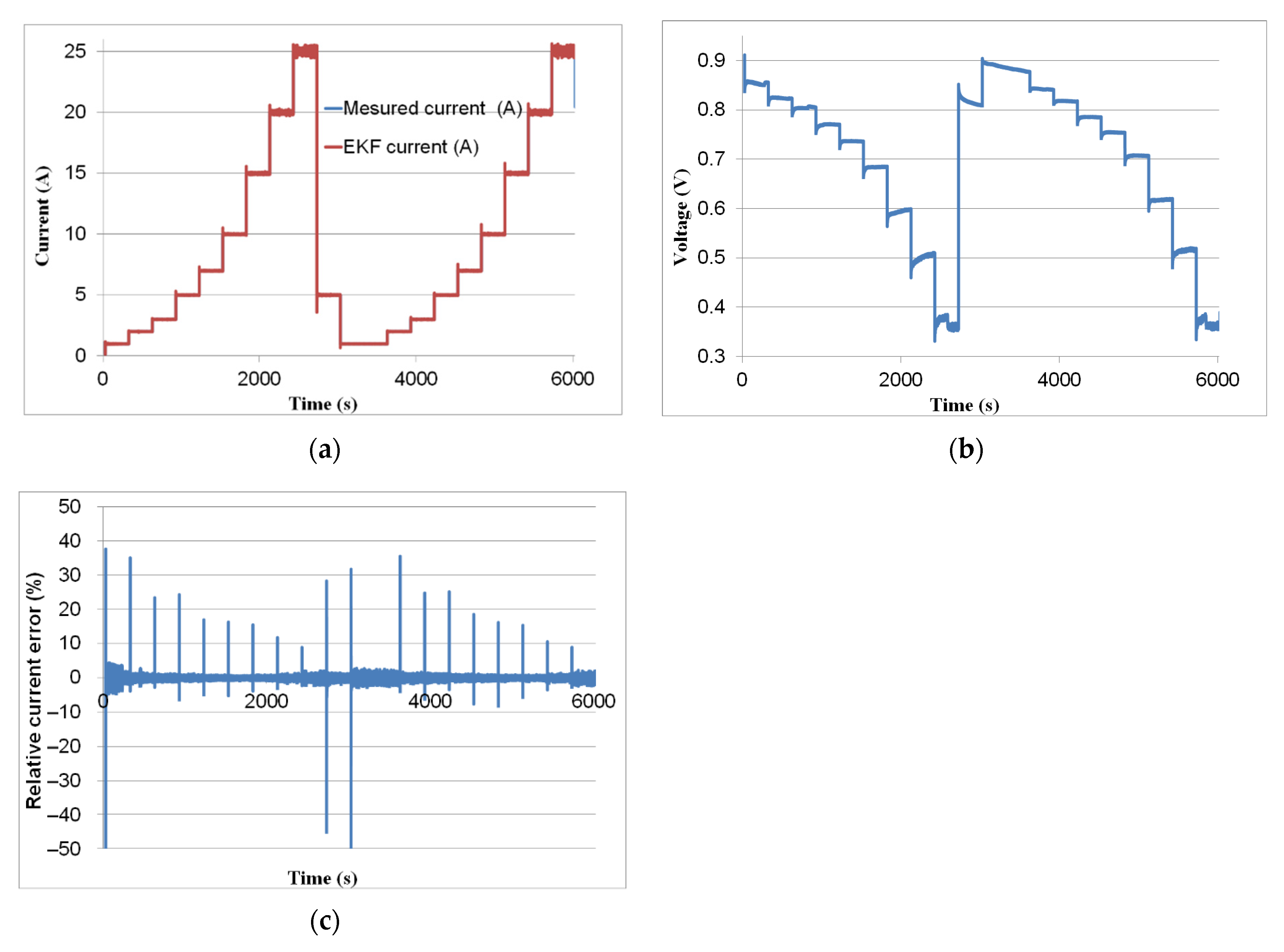
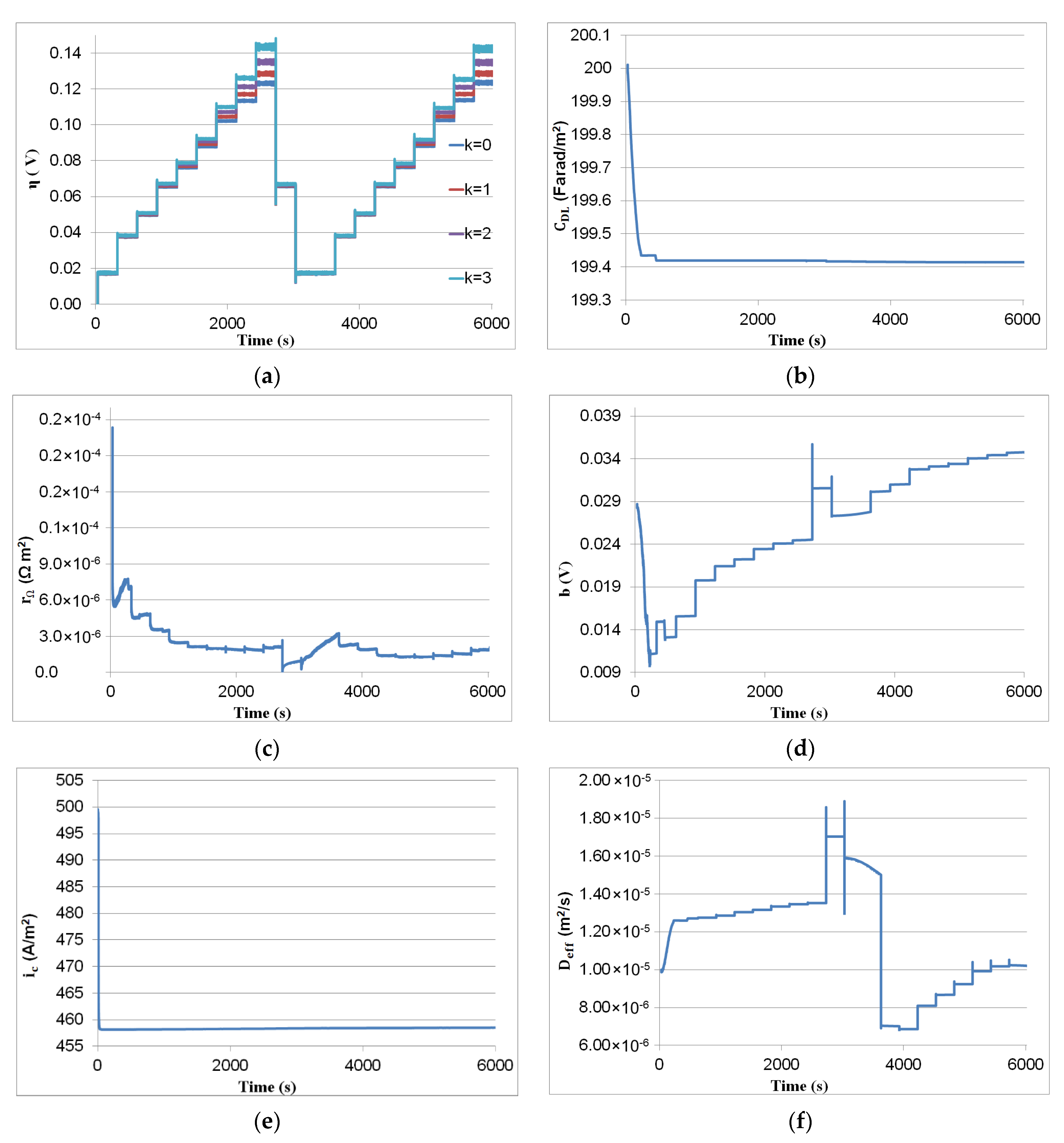
| Geometry and Model Parameters | |||||
|---|---|---|---|---|---|
| Parameter | Unit | Signification | m/s | Constant | |
| V | Tafel slope | M | Spatial coordinate | ||
| mol/m3 | Oxygen concentration in the channel | M | Spatial coordinate | ||
| mol/m3 | Oxygen concentration in the GDL | - | Normalized spatial coordinates | ||
| mol/m3 | Reference concentration on the channel inlet | V | Cathode potential | ||
| - | Normalized oxygen concentrations | - | Normalized potential | ||
| F/m2 | Double-layer capacity | Discretization parameters | |||
| m2/s | Effective diffusivity of the GDL | - | |||
| V | Cell voltage | - | Number of grid points in the x-axis | ||
| V | Fuel cell potential reference | - | |||
| C/mol | Faraday constant | - | Number of grid points in the y-axis | ||
| m | Channel depth | n | - | Number of state variables | |
| m | GDL thickness | Observer parameters | |||
| A/m2 | Exchange current density | - | Constant | ||
| A | Fuel cell current | - | Observation matrix | ||
| A/m2 | Local current density | - | Kalman gain | ||
| - | Normalized Local current density | - | Dynamic matrix | ||
| m | Channel length | - | Time index | ||
| m | Channel width | - | White noise covariance | ||
| A/m2 | Limiting current density | - | Covariance matrix | ||
| Ω m2 | Ohmic resistance | s | Sampling period | ||
| s | Temporal coordinate | - | Measurement noise covariance | ||
| °C | Temperature | - | Process noise | ||
| m/s | Air velocity | - | State variables | ||
| Parameter | Value | Parameter | Value |
|---|---|---|---|
| V | m | ||
| F/m2 | m | ||
| mol/m3 | A/m2 | ||
| m2/s | Ωm2 | ||
| V | °C | ||
| 96,487 C/mol | m/s |
| Period of Real-Time Measurement (s) | Number of Samples | Period of Simulation Time (s) | |
|---|---|---|---|
| 3979 | 23,471 | 0.1695 | 2340 |
| 6000 | 81,455 | 0.073 | 5188 |
Publisher’s Note: MDPI stays neutral with regard to jurisdictional claims in published maps and institutional affiliations. |
© 2022 by the authors. Licensee MDPI, Basel, Switzerland. This article is an open access article distributed under the terms and conditions of the Creative Commons Attribution (CC BY) license (https://creativecommons.org/licenses/by/4.0/).
Share and Cite
Diab, Y.; Auger, F.; Schaeffer, E.; Chevalier, S.; Allahham, A. Real-Time Estimation of PEMFC Parameters Using a Continuous-Discrete Extended Kalman Filter Derived from a Pseudo Two-Dimensional Model. Energies 2022, 15, 2337. https://doi.org/10.3390/en15072337
Diab Y, Auger F, Schaeffer E, Chevalier S, Allahham A. Real-Time Estimation of PEMFC Parameters Using a Continuous-Discrete Extended Kalman Filter Derived from a Pseudo Two-Dimensional Model. Energies. 2022; 15(7):2337. https://doi.org/10.3390/en15072337
Chicago/Turabian StyleDiab, Yasser, Francois Auger, Emmanuel Schaeffer, Stéphane Chevalier, and Adib Allahham. 2022. "Real-Time Estimation of PEMFC Parameters Using a Continuous-Discrete Extended Kalman Filter Derived from a Pseudo Two-Dimensional Model" Energies 15, no. 7: 2337. https://doi.org/10.3390/en15072337
APA StyleDiab, Y., Auger, F., Schaeffer, E., Chevalier, S., & Allahham, A. (2022). Real-Time Estimation of PEMFC Parameters Using a Continuous-Discrete Extended Kalman Filter Derived from a Pseudo Two-Dimensional Model. Energies, 15(7), 2337. https://doi.org/10.3390/en15072337







